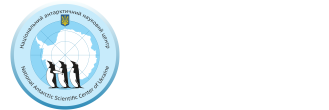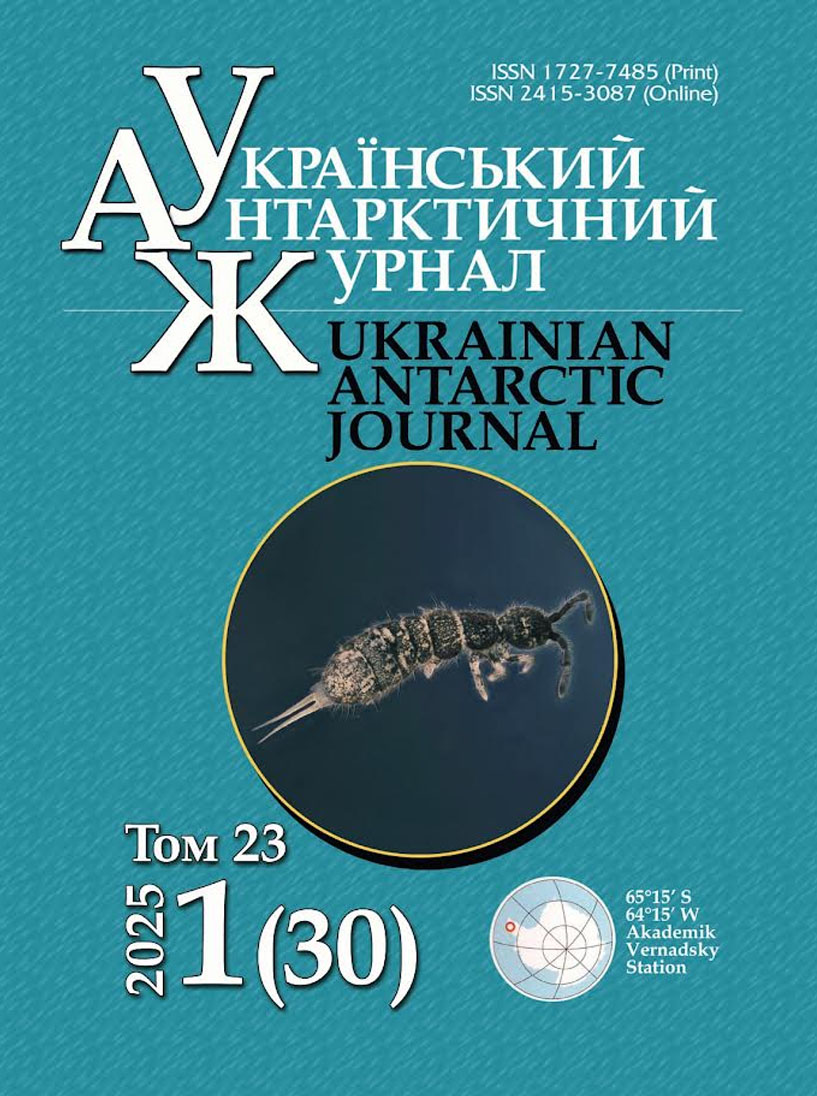- Антарктика,
- віддалені екосистеми,
- вплив на довкілля,
- забруднення пластиком,
- морські живі організми
- управління відходами ...Більше
Авторське право (c) 2025 Український антарктичний журнал

Ця робота ліцензується відповідно до Creative Commons Attribution-NonCommercial-NoDerivatives 4.0 International License.
Анотація
Забруднення пластиком в Антарктиді є серйозною екологічною проблемою, яка останніми роками привернула міжнародну увагу. Стаття досліджує фактори, що впливають на полярний пластик, включаючи його розподіл, накопичення, соціально-економічні наслідки, узгодженість дій зацікавлених сторін, способи зменшення забруднення та політику, яка може впливати на забруднення пластиком в Антарктиді. Проблема забруднення пластиком надзвичайно важлива для збереження довкілля в Антарктиді та на планеті. Поширення забруднення пластиком в Антарктиці здебільшого зумовлене океанічними течіями, які переносять сміття з інших частин світу. Поширення пластику зумовлене головним чином діяльністю людини, яка спричинила значну деградацію довкілля. Зараз воно перебуває в циклі розширення до універсальної проблеми, пов’язаної з кліматом. Згідно з дослідженнями, пластикові відходи зосереджені в певних частинах Антарктиди, зокрема в районах, вільних від льоду. Підвищуючи екологічну обізнаність щодо шкідливого впливу мікропластику на навколишнє середовище, більше активістів могли б звернути увагу на важливість інвестування в інноваційні альтернативні матеріали, просування принципів рециркуляції для управління відходами, втручання уряду та заохочення співпраці між зацікавленими сторонами на глобальному рівні. Поєднуючи освіту, інновації, регулювання та громадські ініціативи, ми можемо рухатися у світ, де накопичення пластику скорочується та контролюється, що призведе до безпечного середовища без біологічних наслідків в Антарктичному регіоні. Завдяки цьому ми можемо суттєво змінити споживання пластику та зберегти біорізноманіття. Крім того, залучення наукових спільнот до довгострокового моніторингу та сприяння екологічно чистим експедиціям є життєво важливим для забезпечення прогресу. Зміцнення міжнародних договорів може посилити дотримання правил щодо використання та утилізації пластику. Спільні зусилля окремих осіб, установ та урядів можуть мати значний вплив, відновивши пошкоджене та створивши прецедент для захисту навколишнього середовища в усьому світі.
Посилання
- Abalansa, S., El Mahrad, B., Vondolia, G. K., Icely, J., & Newton, A. (2020). The marine plastic litter issue: a socio-economic analysis. Sustainability, 12(20), 8677. https://doi.org/10.3390/su12208677
- Abbott, J. K., & Sumaila, U. R. (2019). Reducing marine plastic pollution: Policy insights from economics. Review of Environmental Economics and Policy, 13(2), 327–336. https://doi.org/10.1093/reep/rez007
- Agamuthu, P., Mehran, S. B., Norkhairah, A., & Norkhairiyah, A. (2019). Marine debris: A review of impacts and global initiatives. Waste Management & Research: The Journal for a Sustainable Circular Economy, 37(10), 987–1002. https://doi.org/10.1177/0734242X19845041
- Agnes, M., Adeboye, A., & Huang, Q. (2020). Prevention and control of plastic waste pollution in the polar region: a review. International Journal of Scientific and Research Publications, 10(12), 11–20. https://doi.org/10.29322/ijsrp.10.12.2020.p10803
- Alimba, C. G., & Faggio, C. (2019). Microplastics in the marine environment: Current trends in environmental pollution and mechanisms of toxicological profile. Environmental Toxicology and Pharmacology, 68, 61–74. https://doi.org/10.1016/j.etap.2019.03.001
- Almela, P., & Gonzalez, S. (2020). Are Antarctic Specially Protected Areas safe from plastic pollution? A survey of plastic litter at Byers Peninsula, Livingston Island, Antarctica. Advances in Polar Science, 31(04), 284–290. https://doi.org/10.13679/J.ADVPS.2020.0029
- Avery-Gomm, S., Borrelle, S. B., & Provencher, J. F. (2018). Linking plastic ingestion research with marine wildlife conservation. Science of The Total Environment, 637–638, 1492–1495. https://doi.org/10.1016/j.scitotenv.2018.04.409
- Aves, A. R., Revell, L. E., Gaw, S., Ruffell, H., Schuddeboom, A., Wotherspoon, N. E., LaRue, M., & McDonald, A. J. (2022). First evidence of microplastics in Antarctic snow. The Cryosphere, 16(6), 2127–2145. https://doi.org/10.5194/tc-16-2127-2022
- Avio, C. G., Gorbi, S., & Regoli, F. (2017). Plastics and microplastics in the oceans: From emerging pollutants to emerged threat. Marine Environmental Research, 128, 2–11. https://doi.org/10.1016/j.marenvres.2016.05.012
- Bargagli, R., & Rota, E. (2023). Microplastic interactions and possible combined biological effects in Antarctic marine ecosystems. Animals, 13(1), 162. https://doi.org/10.3390/ani13010162
- Beaumont, N. J., Aanesen, M., Austen, M. C., Börger, T., Clark, J. R., Cole, M., Hooper, T., Lindeque, P. K., Pascoe, C., & Wyles, K. J. (2019). Global ecological, social and economic impacts of marine plastic. Marine Pollution Bulletin, 142, 189–195. https://doi.org/10.1016/J.MARPOLBUL.2019.03.022
- Bhardwaj, L. K. (2024). Occurrence of microplastics (MPs) in Antarctica and its impact on the health of organisms. Maritime Technology and Research, 6(2), 265418. https://doi.org/10.33175/mtr.2024.265418
- Chin, L. W., & Fung, T. H. (2018). Plastic in Marine Litter. In R. M. Harrison, & R. E. Hester (Eds.), Plastic and the Environment (pp. 21–59). https://doi.org/10.1039/9781788013314-00021
- Collins, C., & Hermes, J. C. (2019). Modelling the accumulation and transport of floating marine micro-plastics around South Africa. Marine Pollution Bulletin, 139, 46–58. https://doi.org/10.1016/j.marpolbul.2018.12.028
- Coyle, R., Hardiman, G., & O’Driscoll, K. (2020). Microplastics in the marine environment: A review of their sources, distribution processes, uptake and exchange in ecosystems. Case Studies in Chemical and Environmental Engineering, 2, 100010. https://doi.org/10.1016/j.cscee.2020.100010
- Cunningham, E. M., Ehlers, S. M., Dick, J. T. A., Sigwart, J. D., Linse, K., Dick, J. J., & Kiriakoulakis, K. (2020). High abundances of microplastic pollution in deepsea sediments: evidence from Antarctica and the Southern Ocean. Environmental Science & Technology, 54(21), 13661–13671. https://doi.org/10.1021/acs.est.0c03441
- do Sul, J. A. I., Barnes, D. K. A., Costa, M. F., Convey, P., Costa, E. S., & Campos, L. S. (2011). Plastics in the Antarctic environment: are we looking only at the tip of the iceberg? Oecologia Australis, 15(1), 150–170. https://doi.org/10.4257/oeco.2011.1501.11
- Eriksen, M., Thiel, M., & Lebreton, L. (2016). Nature of plastic marine pollution in the Subtropical gyres. In H. Takada, & H. K. Karapanagioti (Eds.), Hazardous Chemicals Associated with Plastics in the Marine Environment. The Handbook of Environmental Chemistry (Vol. 78, pp. 135–162). Springer, Cham. https://doi.org/10.1007/698_2016_123
- Finger, J. V. G., Corá, D. H., Convey, P., Cruz, F. S., Petry, M. V., & Krüger, L. (2021). Anthropogenic debris in an Antarctic Specially Protected Area in the maritime Antarctic. Marine Pollution Bulletin, 172, 112921. https://doi.org/10.1016/j.marpolbul.2021.112921
- Funduk, M., Tutman, P., Farkaš, A., Tišma, S., & Boromisa, A. M. (2021). Marine litter in Croatian Adriatic: sources, quantities and stakeholders′ perspectives. Sustainability, 13(9), 4691. https://doi.org/10.3390/su13094691
- García-Gómez, J. C., Garrigós, M., & Garrigós, J. (2021). Plastic as a vector of dispersion for marine species with invasive potential. A review. Frontiers of Ecology and Evolution, 9, 629756. https://doi.org/10.3389/fevo.2021.629756
- Gewert, B., Plassmann, M. M., & MacLeod, M. (2015). Pathways for degradation of plastic polymers floating in the marine environment. Environmental Science: Processes & Impacts, 17(9), 1513–1521. https://doi.org/10.1039/c5em00207a
- GRID-Arendal, Raubenheimer, K., & Urho, N. (2023). Science-policy interface for plastic pollution. Arendal: GRID Arendal.
- Jansen, M. A. K., Andrady, A. L., Bornman, J. F., Aucamp, P. J., Bais, A. F., Banaszak, A. T., Barnes, P. W., Bernhard, G. H., Bruckman, L. S., Busquets, R., Häder, D. P., Hanson, M. L., Heikkilä, A. M., Hylander, S., Lucas, R. M., Mackenzie, R., Madronich, S., Neale, P. J., Neale, R. E., …& Zhu, L. (2024). Plastics in the Environment in the Context of UV Radiation, Climate Change, and the Montreal Protocol: UNEP Environmental Effects Assessment Panel, Update 2023. Photochemical and Photobiological Sciences, 23, 629–650. https://doi.org/10.1007/s43630-024-00552-3
- Lacerda, A. L. d. F., Rodrigues, L. dos S., van Sebille, E., Rodrigues, F. L., Ribeiro, L., Secchi, E. R., Kessler, F., & Proietti, M. C. (2019). Plastics in sea surface waters around the Antarctic Peninsula. Scientific Reports, 9, 3977. https://doi.org/10.1038/s41598-019-40311-4
- Li, W. C., Tse, H. F., & Fok, L. (2016). Plastic waste in the marine environment: A review of sources, occurrence and effects. Science of The Total Environment, 566–567, 333–349. https://doi.org/10.1016/j.scitotenv.2016.05.084
- Madricardo, F., Ghezzo, M., Nesto, N., Mc Kiver, W. J., Faussone, G. C., Fiorin, R., Riccato, F., Mackelworth, P. C., Basta, J., De Pascalis, F., Kruss, A., Petrizzo, A., & Moschino, V. (2020). How to deal with seafloor marine litter: an overview of the state-of-the-art and future perspectives. Frontiers in Marine Science, 7, 505134. https://doi.org/10.3389/fmars.2020.505134
- Nguyen, L., & Brouwer, R. (2022). Fishing for litter: creating an economic market for marine plastics in a sustainable fisheries model. Frontiers in Marine Science, 9, 722815. https://doi.org/10.3389/fmars.2022.722815
- Pettipas, S., Bernier, M., & Walker, T. R. (2016). A Canadian policy framework to mitigate plastic marine pollution. Marine Policy, 68, 117–122. https://doi.org/10.1016/J.MARPOL.2016.02.025
- Proshad, R., Kormoker, T., Islam, M. S., Haque, M. A., Rahman, M. M., & Mithu, M. M. R. (2018). Toxic effects of plastic on human health and environment: consequences of health risk assessment in Bangladesh. International Journal of Health, 6(1), 1–5. https://doi.org/10.14419/ijh.v6i1.8655
- Raubenheimer, K., & McIlgorm, A. (2017). Is the Montreal Protocol a model that can help solve the global marine plastic debris problem? Marine Policy, 81, 322–329. https://doi.org/10.1016/J.MARPOL.2017.04.014
- Roman, L., Schuyler, Q., Wilcox, C., & Hardesty, B. D. (2020). Plastic pollution is killing marine megafauna, but how do we prioritise policies to reduce mortality? Conservation Letters, 14(2), e12781. https://doi.org/10.1111/conl.12781
- Rota, E., Bergami, E., Corsi, I., & Bargagli, R. (2022). Macro- and microplastics in the Antarctic environment: ongoing assessment and perspectives. Environments, 9(7), 93. https://doi.org/10.3390/environments9070093
- Sheavly, S. B., & Register, K. M. (2007). Marine Debris & Plastics: Environmental Concerns, Sources, Impacts and Solutions. Journal of Polymers and the Environment, 15, 301–305. https://doi.org/10.1007/S10924-007-0074-3
- Thushari, G. G. N., & Senevirathna, J. D. M. (2020). Plastic pollution in the marine environment. Heliyon, 6(8), e04709. https://doi.org/10.1016/j.heliyon.2020.e04709
- Waller, C. L., Griffiths, H. J., Waluda, C. M., Thorpe, S. E., Loaiza, I., Moreno, B., Pacherres, C. O., & Hughes, K. A. (2017). Microplastics in the Antarctic marine system: An emerging area of research. Science of The Total Environment, 598, 220–227. https://doi.org/10.1016/j.scitotenv.2017.03.283
- Xanthos, D., & Walker, T. R. (2017). International policies to reduce plastic marine pollution from singleuse plastics (plastic bags and microbeads): A review. Marine Pollution Bulletin, 118(1–2), 17–26. https://doi.org/10.1016/j.marpolbul.2017.02.048
- Zhang, M., Haward, M., & McGee, J. (2020). Marine plastic pollution in the polar south: Responses from Antarctic Treaty System. Polar Record, 56, e36. https://doi.org/10.1017/s0032247420000388


